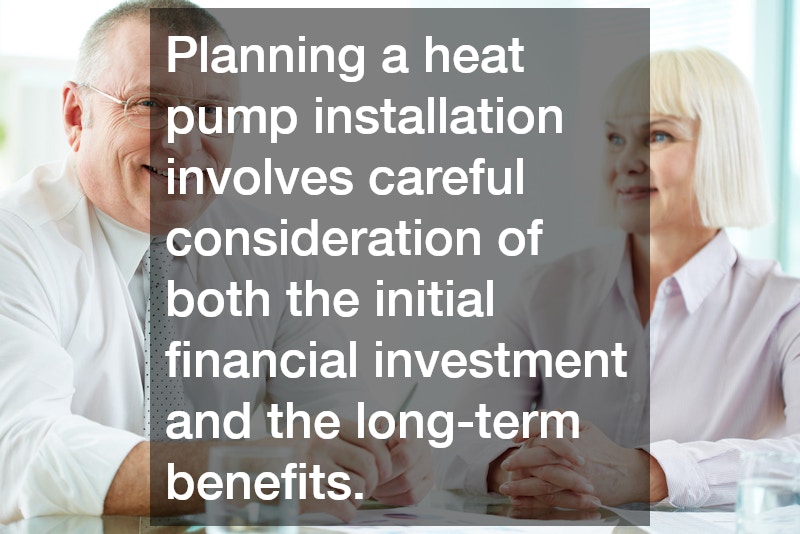Heat pump installation is a significant investment for homeowners aiming to boost energy efficiency and comfort in their homes. This long-form article will guide you through essential considerations and answer common questions about planning a heat pump installation. Understanding these factors will help ensure a successful and efficient installation process.
What are the Initial Costs and Long-term Savings of a Heat Pump Installation?
Understanding the Upfront Costs
Delving into the initial investment for a heat pump can reveal various components that contribute to the cost. Beyond the retail price of the unit itself, installation fees and potential home modifications could add to the expenses.
These modifications might include upgrading the electrical system or enhancing insulation to accommodate the new system efficiently.
The cost can vary significantly based on the type of heat pump you choose. Air source heat pumps may be more affordable upfront compared to ground source systems, but both require careful consideration of installation complexity. The location and climate of your home can further affect the cost, with certain areas requiring more extensive changes.
Another financial aspect to consider is the potential need for auxiliary heating solutions during extreme cold. This can add to both installation and operational costs but ensure effective performance throughout the year. Understanding these expenses in detail can prevent unexpected financial surprises during the process.
Availability of Incentives and Rebates
Many governments and local agencies offer incentives, rebates, or tax credits to encourage the use of energy-efficient appliances like heat pumps. These financial aids can alleviate some of the initial costs associated with purchasing and installing a heat pump. Investigating these options can lead to substantial savings, making the installation more financially feasible.
The requirements for rebates and incentives can vary, with criteria such as the efficiency rating of the unit or the completion of installation by a certified professional. It’s crucial to research and apply for all eligible programs before starting the installation process. By doing so, homeowners can take advantage of significant cost reductions, easing the financial burden of such an investment.
Additionally, homeowners should consider the long-term financial benefits these incentives provide. Not only can they reduce the upfront costs, but rebates and credits can also be structured to reward sustained energy savings over time. This dual benefit makes them an attractive option for those considering a heat pump installation.
How to Choose the Right Type and Size of Heat Pump?
Types of Heat Pumps
There are several types of heat pumps available, each suited to different needs and environmental conditions. Air source heat pumps are popular due to their ease of installation and versatility in various climates. Ground source heat pumps, though more expensive, offer higher efficiency by using the stable ground temperature to regulate home heating and cooling.
In some cases, hybrid systems might be the best choice, combining features of both air and ground source heat pumps. These systems can switch between the two sources based on season and efficiency, optimizing energy use throughout the year. Such adaptability makes hybrid systems a suitable choice for variable climates with extreme weather conditions.
When choosing a type of heat pump, it is crucial to consider both the local climate and the specific needs of your home. Evaluate factors like temperature variations, humidity levels, and the layout of your home to determine the best fit. Consulting with industry professionals can help make this decision more accurately.
Sizing Considerations for Your Space
The proper sizing of a heat pump is critical to ensuring efficient operation and comfort. An undersized heat pump may struggle to meet the heating and cooling demands of a home, leading to increased wear and higher utility costs. Conversely, an oversized unit may cycle on and off too frequently, reducing its lifespan and efficiency.
Professional installers typically conduct a load calculation to determine the correct size needed for your specific situation. This involves considering various factors such as the home’s insulation, window types, occupancy levels, and local climate. The goal is to strike a balance between capacity and efficiency to maintain optimal home comfort.
Failure to properly size the heat pump can negatively impact its performance and the homeowner’s satisfaction. It is worth investing the time and, if necessary, additional resources in getting this step right. By ensuring proper sizing, homeowners can enjoy consistent comfort and energy savings.
Planning a heat pump installation involves careful consideration of both the initial financial investment and the long-term benefits. By understanding the costs, evaluating different types and sizes of heat pumps, and taking advantage of available incentives, homeowners can make informed decisions that enhance their home’s comfort and energy efficiency. Armed with this knowledge, you can confidently embark on your heat pump installation journey.
.

